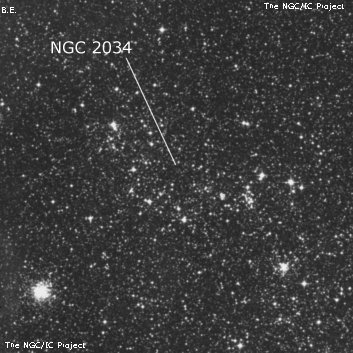
John Herschel discovered NGC 2034 = h2914 on 3 Jan 1837 and described "a more condensed part of the great cluster (sweep 761, 39), of a crescent-like form, occupying one field. Rich and fine." His position corresponds with association LH 84 at the northeast end of the "Quadrant" feature of the LMC. NGC 2034 = h2914 and NGC 2027 = h2908 both described the same field, though NGC 2027 is on the west end of the association. Harold Corwin considers NGC 2027 to refer to the entire region.
James Dunlop discovered the association on 6 Nov 1826 and described D 241 as "a large cluster of small stars of mixt magnitudes in strong nebula; irregular extended figure." His position falls at the east end association LH 77 or the west end of LH 84, known as the LMC "Quadrant" (of a circle).
300/350mm - 13.1" (2/20/04 - Costa Rica): at 105x this is an interesting, elongated curving cluster or association (LH 84), situated northwest of the compact cluster NGC 2041. This condensed portion of LH 84 contains a couple of dozen mag 12-13 stars and a wide pair of mag 10 stars (including HD 269855) on the north side. The resolved stars are embedded in an unresolved glow of fainter stars, ~4'x2', extended E-W in a crescent shape, arching north on both ends. NGC 2034 is located at the east end of an impressive star cloud (collectively known as the "Quadrant" = LH 77), looping 30' W (bending south in the middle) to NGC 2002.
Notes by Steve Gottlieb